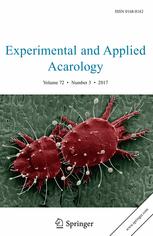Ver ítem
- xmlui.general.dspace_homeCentros Regionales y EEAsCentro Regional Santa FeEEA RafaelaArtículos científicosxmlui.ArtifactBrowser.ItemViewer.trail
- Inicio
- Centros Regionales y EEAs
- Centro Regional Santa Fe
- EEA Rafaela
- Artículos científicos
- Ver ítem
A morphological and phylogenetic analysis of Ornithodoros marinkellei (Acari: Argasidae), with additional notes on habitat and host usage
Resumen
Ornithodoros marinkellei was described from larvae collected on Pteronotus spp. bats in Colombia and Panama. More recently, this tick was reported in the Brazilian Amazon. Because some morphometric differences were observed between O. marinkellei larvae from Colombia and Brazil, it was proposed that further investigations were needed to assess whether the differences could be attributed to intra- or inter-specific polymorphism. Herein, we collected O.
[ver mas...]
Ornithodoros marinkellei was described from larvae collected on Pteronotus spp. bats in Colombia and Panama. More recently, this tick was reported in the Brazilian Amazon. Because some morphometric differences were observed between O. marinkellei larvae from Colombia and Brazil, it was proposed that further investigations were needed to assess whether the differences could be attributed to intra- or inter-specific polymorphism. Herein, we collected O. marinkellei specimens in the type locality of Colombia, in Brazil, and in a new locality in Nicaragua, expanding the distribution of the species to Nicaragua. Morphometric analysis of larvae and adults, corroborated by a principal component analysis (PCA), indicated that the Brazilian specimens were larger than specimens from Colombia and Nicaragua. Phylogenetic analysis inferred from the mitochondrial 16S rRNA gene showed ticks from Colombia and Nicaragua more genetically related than any of them with ticks from Brazil, although ticks from the three countries grouped in a clade sister to a major clade containing sequences of various Neotropical Ornithodoros species. We concluded that ticks identified as O. marinkellei from Colombia, Nicaragua, and Brazil represent the same taxon, and that the genetic and morphological differences between them are likely to have a geographical bias. We redescribed the nymph of O. marinkellei, which has a vestigial hypostome, probably incompatible with blood feeding. We also report human infestation by O. marinkellei adults. As all reports of O. marinkellei adults have been from hot caves (temperature > 35 °C), this abiotic condition could be a limiting factor for the occurrence of this tick species.
[Cerrar]

Autor
Venzal, José Manuel;
Nava, Santiago;
Hernández, Ligia V.;
Miranda, Jorge;
Marcili, Arlei;
Labruna, Marcelo B.;
Fuente
Experimental and Applied Acarology 76 (2) : 249–261 (October 2018)
Fecha
2018-10
Editorial
Springer
ISSN
0168-8162
1572-9702
1572-9702
Formato
pdf
Tipo de documento
artículo
Palabras Claves
Derechos de acceso
Restringido
 Excepto donde se diga explicitamente, este item se publica bajo la siguiente descripción: Creative Commons Attribution-NonCommercial-ShareAlike 2.5 Unported (CC BY-NC-SA 2.5)
Excepto donde se diga explicitamente, este item se publica bajo la siguiente descripción: Creative Commons Attribution-NonCommercial-ShareAlike 2.5 Unported (CC BY-NC-SA 2.5)

